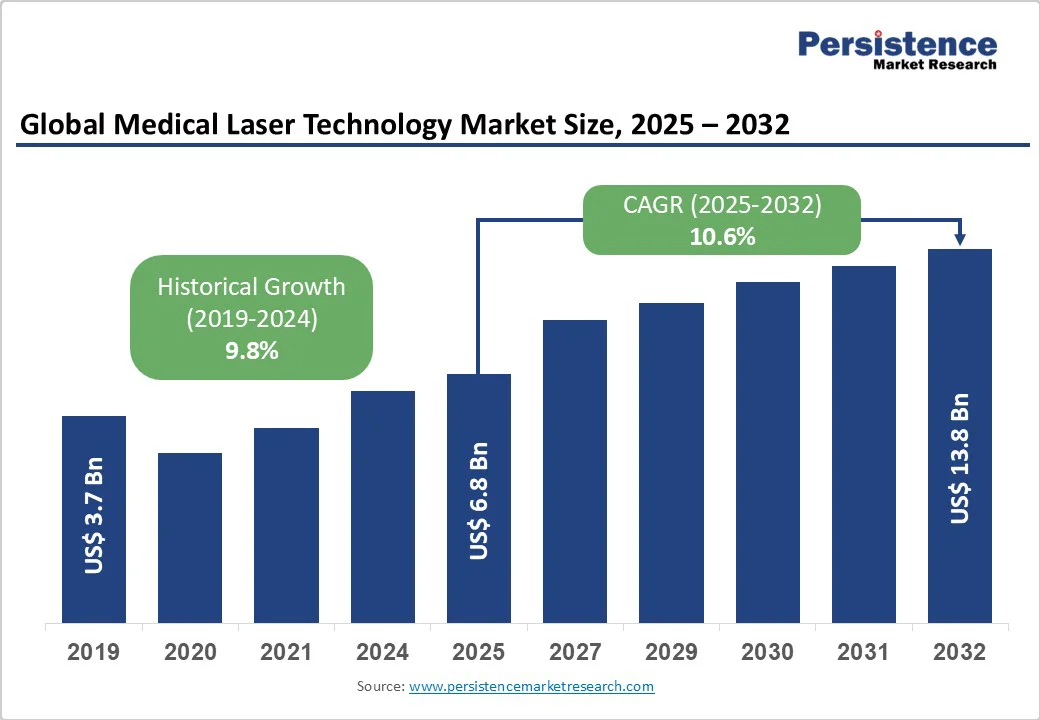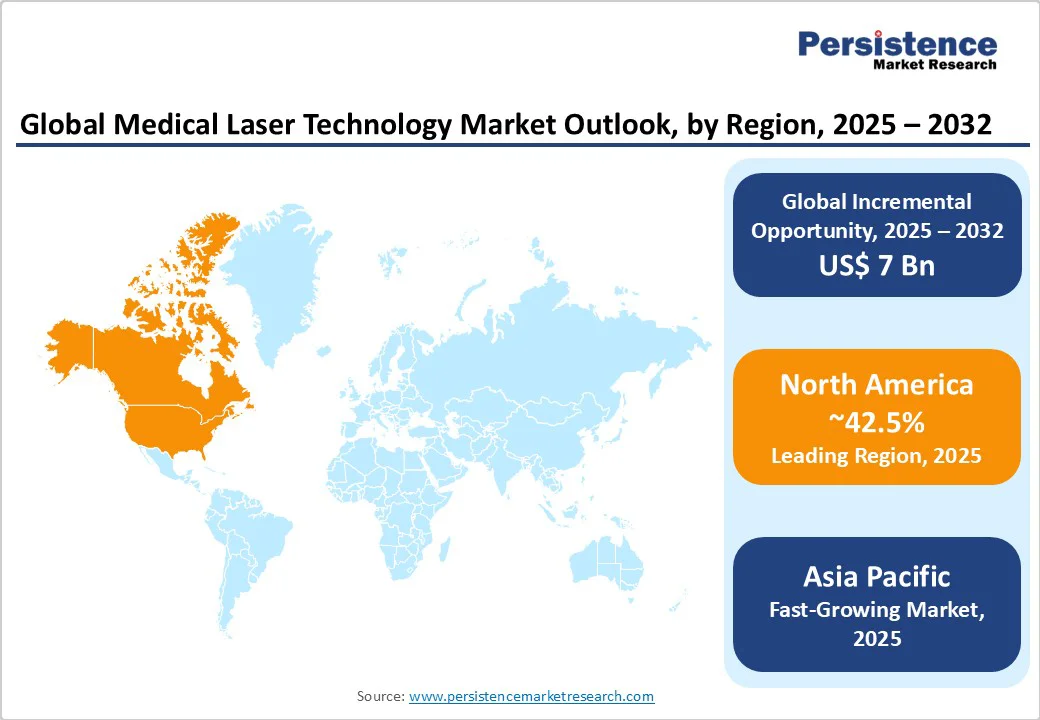ID: PMRREP4518| 187 Pages | 26 Sep 2025 | Format: PDF, Excel, PPT* | Healthcare

The global medical laser technology market is likely to value at US$6.8 Bn in 2025 and reach US$13.8 Bn by 2032, growing at a CAGR of 10.6% during the forecast period from 2025 to 2032.
The medical laser technology market is experiencing robust growth driven by increasing demand for minimally invasive procedures, advancements in laser technology, and rising applications in medical fields such as dermatology, ophthalmology, and cardiovascular treatments.
| Key Insights | Details |
|---|---|
| Medical Laser Technology Market Size (2025E) | US$ 6.8Bn |
| Market Value Forecast (2032F) | US$13.8Bn |
| Projected Growth (CAGR 2025 to 2032) | 10.6% |
| Historical Market Growth (CAGR 2019 to 2024) | 9.8% |

The global medical laser technology market is experiencing robust growth, fueled by the rising preference for minimally invasive procedures across diverse medical specialties. Medical lasers provide unparalleled precision, minimize patient recovery times, and reduce risks compared to conventional surgical methods.
This makes them highly sought after in applications such as laser eye surgery, skin resurfacing, and tumor ablation. In North America, this trend is underscored by the American Society of Plastic Surgeons’ report of a 6% increase in laser-based cosmetic procedures in 2024, highlighting growing patient demand.
In Asia Pacific region, countries such as India and South Korea are witnessing a surge in medical tourism, driven by affordable and high-quality laser treatments. Industry leaders such as Lumenix and Cynosure have reported significant sales growth of laser systems tailored for dermatology and ophthalmology, reflecting strong market demand.
Additionally, government initiatives aimed at advancing healthcare technologies and infrastructure are fostering an environment of innovation and adoption, supporting sustained market expansion through 2032 and beyond.
The medical laser technology market faces challenges due to the high costs of laser equipment and stringent regulatory requirements. Advanced laser systems, such as those used in cardiovascular and oncology treatments, require significant capital investment, limiting adoption in smaller healthcare facilities. In 2023, the average cost of a medical laser system ranged from $50,000 to $500,000, posing a barrier for budget-constrained hospitals in developing regions.
Additionally, regulatory approvals from bodies such as the U.S. FDA and the European Medicines Agency involve lengthy and complex processes, delaying product launches. For instance, BIOLASE reported delays in launching new dental laser systems in 2024 due to compliance requirements. These factors, combined with the need for skilled professionals to operate laser systems, hinder market growth, particularly in cost-sensitive and less-regulated markets.
The increasing adoption of medical lasers in oncology and regenerative medicine presents significant opportunities. Lasers are increasingly used for precise tumor removal, photodynamic therapy, and tissue regeneration, driven by rising cancer prevalence and demand for innovative treatments.
The International Agency for Research on Cancer projects the number of new cancer cases worldwide is expected to rise by approximately 77%, from 20 million in 2022 to 35 million by 2050, boosting demand for laser-based therapies. In regenerative medicine, lasers are used for wound healing and tissue engineering, with companies such as biolitec AG developing advanced systems for these applications.
Government funding, such as the EU’s Horizon Europe program which allocates 593 billion for health innovation in 2024, supports research in laser-based treatments. The Asia Pacific’s growing biotechnology sector, particularly in China and Japan, further drives demand for laser technologies, creating opportunities for manufacturers to innovate and capture market share through 2032.

North America dominates the medical laser technology market, accounting for 42.5% of market share in 2025, propelled by advanced healthcare infrastructure, high adoption of laser technologies, and significant investments in the U.S. and Canada. The U.S. healthcare industry, valued at $4.5 trillion in 2025 per the Centers for Medicare & Medicaid Services, relies heavily on lasers for surgical and cosmetic applications.
Canada’s healthcare sector drives demand for laser systems in ophthalmology and dentistry, supported by the Canadian Institutes of Health Research. Major players, such as BIOLASE and Cynosure, dominate with robust distribution networks, catering to advanced hospitals and clinics. The region’s focus on minimally invasive procedures and consumer preference for high-quality laser systems strengthen its market position through 2032.
Asia Pacific is the fastest-growing region, driven by rising healthcare expenditure, increasing medical tourism, and rapid adoption of advanced technologies in countries such as China and India. China’s healthcare sector, valued at $1.3 trillion in 2024 per the National Health Commission, supports demand for laser systems in hospitals and clinics. India’s medical tourism industry, projected to reach $13 Bn by 2026, drives demand for cost-effective laser treatments in dermatology and ophthalmology.
Companies such as Topcon and Dentsply Sirona are expanding their presence in the region, capitalizing on government initiatives such as India’s Ayushman Bharat program. The region’s growing biotechnology sector and increasing prevalence of chronic diseases ensure sustained market growth through 2032.
Europe is the second fastest-growing region driven by stringent healthcare regulations, increasing demand in dermatology and ophthalmology, and ongoing infrastructure development, particularly in Germany and France. The European healthcare market robustly supports the use of laser systems across surgical and aesthetic applications.
Germany’s medical technology sector, a major consumer of diode and solid-state lasers, benefits from industry leaders such as biolitec AG and Philips Healthcare, driving innovation. Additionally, the EU’s Green Deal encourages investments in health innovation, bolstering demand for laser-based oncology treatments.
Europe’s strong emphasis on precision medicine and rigorous safety standards further fuels market growth, compelling companies to innovate and comply with evolving regulations while addressing consumer expectations for safer, more effective laser therapies.

The global medical laser technology market is highly competitive, characterized by a fragmented landscape with numerous global and regional players. Leading companies such as Lumenix, Philips Healthcare, and Cynosure dominate through extensive product portfolios and global distribution networks.
Regional players, such as Topcon, focus on localized offerings in the Asia Pacific. Companies are investing in advanced laser technologies and software integration to enhance precision and market share, driven by demand in dermatology, ophthalmology, and oncology.
The Medical Laser Technology market is projected to reach US$6.8 Bn in 2025.
Rising demand for minimally invasive procedures and expanding applications in oncology are the key market drivers.
The Medical Laser Technology market is poised to witness a CAGR of 10.6% from 2025 to 2032.
The growing applications in oncology and regenerative medicine are the key market opportunities.
Lumenix, Philips Healthcare, Cynosure, and BIOLASE, Inc. are key market players.
| Report Attribute | Details |
|---|---|
| Historical Data/Actuals | 2019 - 2024 |
| Forecast Period | 2025 - 2032 |
| Market Analysis | Value: US$ Bn/Mn, Volume: As Applicable |
| Geographical Coverage |
|
| Segmental Coverage |
|
| Competitive Analysis |
|
| Report Highlights |
|
By Product Type
By Application
By Region
Delivery Timelines
For more information on this report and its delivery timelines please get in touch with our sales team.
About Author